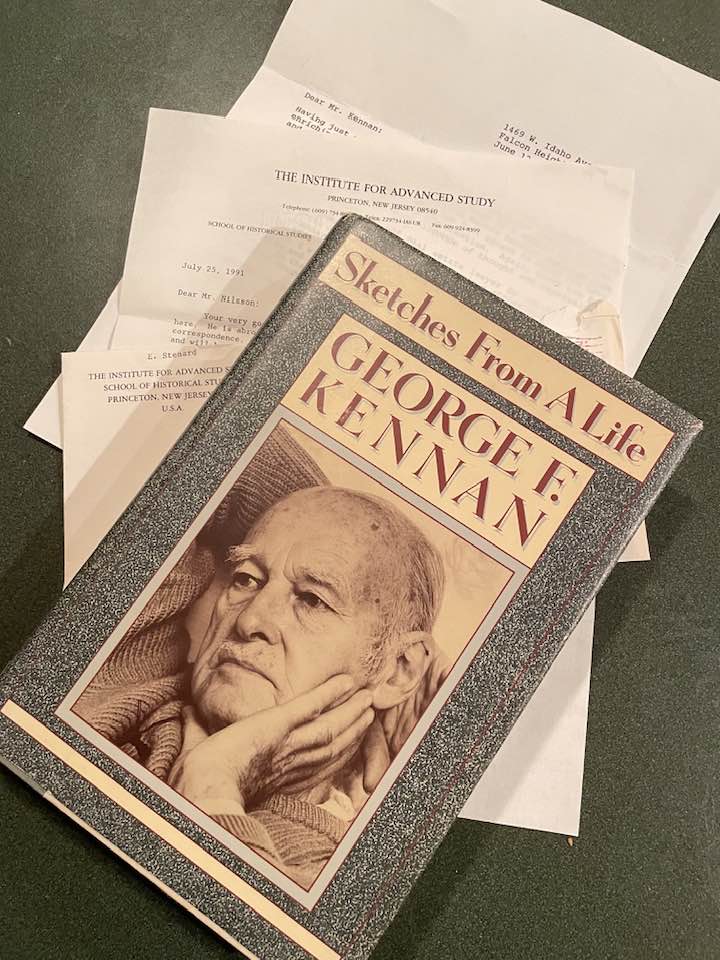MAY 12, 2025 – Publishing a book is not a casual undertaking. Writing the darned thing isn’t even the half of it. In the case of the all the histories I read, a vast amount of scholarship precedes the drafting. Before delving into each book, I check out the author’s bibliography, which reflects what kind of toil was involved in the research. An amazing feat to me is how the author gathers, examines and synthesizes sources, then uses them to support a cogent thesis—all the while in compelling prose. That why, when I encounter an especially well-written and interesting book by a living author, I like to find the author’s contact information and send a note expressing my appreciation for the tremendous effort involved in completing the work. Invariably, I receive a kind reply—which motivates me continually to keep sending “thank you” notes.
The other day I found myself rummaging through a box of books relating to the Cold War. Among them was Sketches from a Life by George F. Kennan. The front of the jacket features a photograph of the author. The picture captures the famous diplomat in a detached, contemplative frame of mind and at a very advanced age. He was 85 when the book was published. He would live to be 101,
I remember well when I acquired the book. My wife and I were browsing through a bookstore one evening after dinner out when our kids were four and two and testing their babysitter’s patience, I’m sure. As usual, Beth wandered off to the literature section while I meandered into history. I soon encountered George Kennan’s book.
I’d been introduced to the name and work of George Kennan years before in a college course on the origins of the Cold War. The reading list included books by John Gaddis, Walter Lippman, Dean Acheson, and the famous “X” article that appeared in the July 1947 issue of Foreign Affairs magazine. “X” of course, was the pseudonym of George F. Kennan, at the time the chargé d’affaires at the United States Embassy in Moscow. The article was entitled “The Sources of Soviet Conduct” and introduced the term, “containment,” which would define U.S. policy toward the Soviet Union for decades to come. I was impressed by Kennan’s analysis and writing and learned to appreciate him as one of the foremost observers of the Soviet Union.
I spent our entire browsing time reading the introduction to Sketches from a Life and was reminded that Kennan was one of the finest writers I’d ever encountered. The book was deeply personal and drew from his journals through the course of his long, fascinating life and various postings during his distinguished career in the State Department. When Beth signaled that it was time for us to head home, I took Sketches straight to the checkout counter.
Over the next week or so I devoured the book and was so impressed, I felt compelled to write to the distinguished diplomat. This was long before “Google” or such a thing as “search engine” existed, so digging around for Kennan’s whereabouts and address took some effort. I tracked him down at The Institute for Advanced Study/School of Historical Studies at Princeton University, whereupon I punched out a letter on our home Selectric typewriter. Dated June 12, 1991, it read,
Dear Mr. Kennan:
Having just read your Sketches from a Life, I wish to thank you for enriching my life. Your insights and eloquence touched my heart and mind, and I have introduced your book to a number of friends. Although I was not unfamiliar with you before reading Sketches from a Life, I had not yet appreciated the full extent to which you have contributed to our culture and civilization. Again, thank you for the chance to experience your elegance of thought and expression.
Although I am a banking and real estate lawyer by vocation (my legal wife, as Chekhov would say), I maintain a strong avocational interest in history, particularly Russian and Soviet History. I also enjoy music and literature, and even fancy myself as a composer or writer someday. Perhaps my flirtations with these Chekovian mistresses will never develop into full-blown affairs, but if nothing else, I will instill in my children an appreciation for the liberal arts and a curiosity about the world beyond their immediate horizons. In the process, my children will come to know the heart and mind of George F. Kennan.
I wish you the best of health.
Sincerely,
/s/
Eric B. Nilsson
As it turned out, Mr. Kennan was abroad for several months, but his secretary dutifully sent me a kind reply. The secretary’s letter and a copy of my letter were tucked away inside the front cover of the book.
Just three weeks ago, his name came up again—in my Russian History class at the University of Minnesota. Professor Stavrou highlighted George Kennan’s influence on America’s policy toward the Soviet Union and gave him high marks for his insights. I immediately thought of the diplomat’s famous article in Foreign Affairs and . . . one of the most beautiful works of prose that a reader could experience: Sketches from a Life.
Subscribe to this blog and receive notifications of new posts by email.
© 2025 by Eric Nilsson
